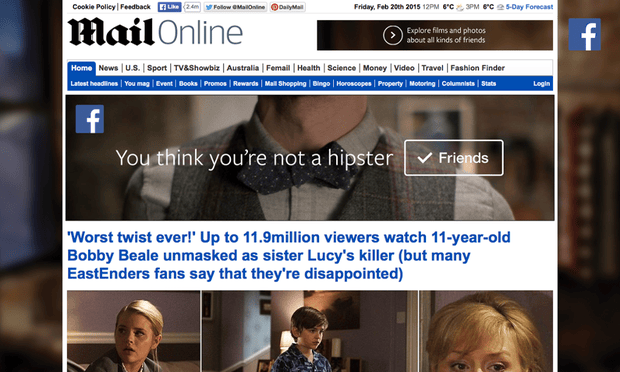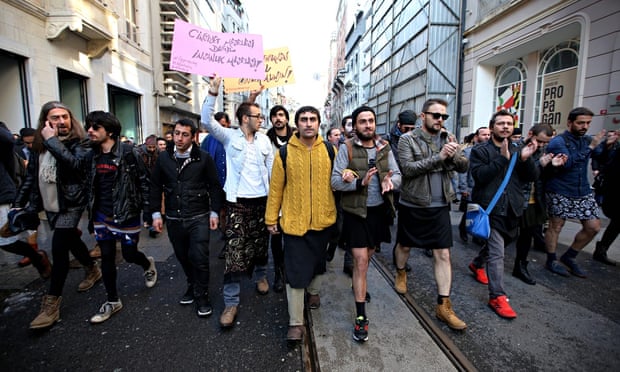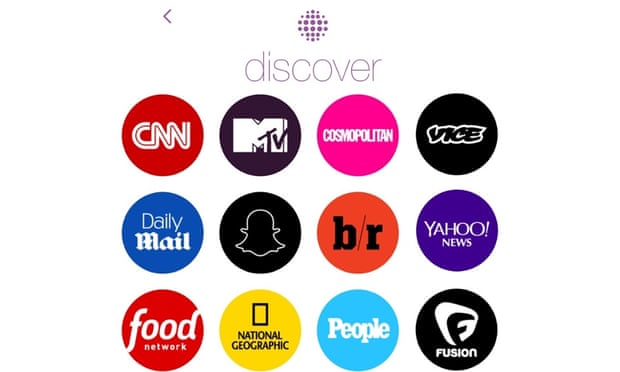Wednesday, 25 February 2015
NDM Story #40 Is Twitter bad for economic growth?
http://www.theguardian.com/business/economics-blog/2015/feb/18/is-twitter-bad-for-economic-growth-bank-of-england?utm_medium=twitter&utm_source=dlvr.it
Technology has been our friend in the past but today the impact “may be less benign”, Haldane said in a speech to university students on Tuesday night. Reviewing the factors behind leaps forward in living standards over centuries, he highlighted how our information revolution may be changing our brains to think fast rather than deep. We are clearly in the midst of an information revolution, with close to 99% of the entire stock of information ever created having been generated this century. This has had real benefits. But it may also have had cognitive costs. One of those potential costs is shorter attention spans,” Haldane told the University of East Anglia. “Some societal trends are consistent with that. The tenure of jobs and relationships is declining. The average tenure of Premiership football managers has fallen by one month per year since 1994. On those trends, it will fall below one season by 2020. And what is true of football is true of finance. Average holding periods of assets have fallen tenfold since 1950. The rising incidence of attention deficit disorders, and the rising prominence of Twitter, may be further evidence of shortening attention spans.”
This article shows that Twitter can be a distraction for some and can therefore have an impact on their standards of living. However, i disagree with this viewpoint.
NDM Story #39 Mail Online soars past 200m monthly browsers as newspaper sites bounce back
This is positive for The Daily Mail as statistics show that the newspaper website remains the most popular in the UK. However, this also means that other online newspapers will feel threatened and would want to be more competitive.
NDM Story #38 Brian Williams has gone, but false news is bigger business than ever by Emily Bell
I think this is a great example of how stories in the media can actually be exaggerated and those in power can get away with it. Sometimes it goes unnoticed, however in this case Brian Williams has been caught out about his exaggerated story which then gives him a bad representation in the media.
NDM Story #37 Brands must take advantage of Twitter's personal touch
In my opinion, it is very interesting that technology nowadays allows brands to link with other brands. In this case, the social networking site Twitter can track the popularity of other brands such as Lloyds and HSBC through its users.
NDM Story #36 Ferguson’s citizen journalists revealed the value of an undeniable video
In Ferguson, Missouri this week, the public has turned the notion of “see something, say something” back on the state, via a digital tool of enormous power: online pictures and video. Their efforts – which began days before reporters descended when Twitter user @TheePharaoh posted pictures immediately after a police officer killed an unarmed black teenager, Michael Brown – have helped bring international attention to both Brown’s death and law enforcement’s disproportionate response to the ensuing protests. Antonio French, an alderman in nearby St Louis, spent days posting to Twitter pictures and a series of videos of the demonstrations and police actions that he captured on his mobile phone – and was reportedly arrested and then released on Wednesday evening. He is a citizen journalist of the best kind: a credible witness who has helped inform the wider public about a critical matter. Can anyone plausibly doubt that he and the two professional journalists who were briefly taken into custody after police demanded they stop recording were targeted because they were documenting law enforcement actions? Ferguson isn’t the first example of this kind of citizen journalism, which has been going on for years in any number of other places including Iran, Egypt, Occupy Wall Street and Syria. But the videos, blog posts, tweets, and photos from French and others on the ground have complemented the work of the traditional journalists on the scene – and have reminded us of what is becoming a civic duty in today’s America.
It is a good thing that people are using citizen journalism to help reveal the truth. After all, people who are dominant and have power are usually able to get away with negative things they have done (such as the police officer who killed Michael Brown), however footage from the public ensures they do not get away with it.
NDM Story #35 Why more men should fight for women’s rights by Owen Jones
Özgecan Aslan was a 20-year-old psychology student with dreams, fears and aspirations who was tortured and murdered by a man. She could have become just another statistic in a global pandemic of male violence against women, but in Turkey and neighbouring Azerbaijan she has become an icon. Across Twitter, Turkish women have responded by sharing their experiences of harassment, objectification and abuse. But something else happened: men took to the streets wearing miniskirts, protesting at male violence against women and at those who excuse it or play it down.
I think that it is extremely positive that this case has allowed women to express their personal experiences through social media and have gained courage through it by no longer fearing men. Although the death of the 20 year old is upsetting, she has had a positive impact on other women who have faced or are facing similar situations.
Monday, 9 February 2015
NDM Story #34 Snapchat helps Daily Mail and Vice Media get on message with youngsters
The Daily Mail, Vice Media and Snapchat, the messaging app once mainly known for sexting, might seem unlikely allies in shaping the future of media distribution. But in the frenetic search for the next big social media platform, it seems media organisations are prepared to accept unlikely bedfellows in the name of necessity. Such was the case last week when Vice and Mail Online joined CNN, Cosmopolitan, National Geographic and other media brands in launching Snapchat’s new Discover feature. Media partners create what Snapchat calls “editions” – bundles of stories that disappear after 24 hours – for the new platform, with Snapchat’s fledgling editorial team also providing content.
- Messaging apps provide vast scale, with WhatsApp alone said to have 700 million active users, more than double the number on Twitter.
- Snapchat is shy about sharing numbers but in December 2014 TechCrunch reported it had close to 200 million monthly average users, up from 100 million in August, with the company valued at at least $10bn.
- This may be far from Facebook’s 1.39 billion active user base but Snapchat appeals to the kind of youthful audience that Facebook is said to be failing.
The new Snapchat feature allows users to be more interested in the social media site as they now have different links to different companies that provide 24 hour updates/news. The companies are also suited for different people e.g. Cosmopolitan for women and Food Network for both males and females, young and old. There is also MTV for younger users and National Geographic for older users.
NDM Story #33 British jihadi who faked his own death to return to UK is jailed for 12 years
This case is disturbing and disappointing that people take such drastic action and can go as far as to faking their own death through social media.
No More Page 3
1) Research the No More Page 3 campaign. Who started it and why?
'The founder of the campaign is writer and actor Lucy-Anne Holmes, who started it because she became sad that the most prominent photograph of a woman in the widest circulation British newspaper is of a young woman in just her pants. Lucy wrote a letter to the editor of the Sun but knew it would do absolutely nothing. So, using the free tools that internet provides, she started a campaign.'
3) Read this debate in the Guardian regarding whether the campaign should be dropped. What are Barbara Ellen and Susan Boniface's contrasting opinions in the debate?
'The founder of the campaign is writer and actor Lucy-Anne Holmes, who started it because she became sad that the most prominent photograph of a woman in the widest circulation British newspaper is of a young woman in just her pants. Lucy wrote a letter to the editor of the Sun but knew it would do absolutely nothing. So, using the free tools that internet provides, she started a campaign.'
2) What are the six reasons the campaign gives for why Page 3 has to go?
1) It’s 2014! Page 3 was first introduced in the sexist 1970s. A lot has changed over the last 30+ years in our society, we think it’s time The Sun caught up…
2) It’s soft porn in the UK’s no.1 selling family newspaper that children are exposed to. Until 2003 the models were only 16 (and made to dress up in school ties and hats – seriously!) It’s never been OK. One day we’ll look back on this and think “oh my goodness, we did what?!”
3) What does it teach children? They see page after page of pictures of men in clothes doing stuff (running the country, having opinions, achieving in sport!) and what are the women doing in this society they’re learning about? Not much really, other than standing topless in their pants showing their bare breasts for men. It’s not really fair, is it?
4) Women say, do and think so many interesting and incredible things and should be celebrated for their many achievements. They are people, not things! Not ‘that’. The fact that we hear ‘look at the tits on that’ or ‘I’d do that’ is disgusting, disrespectful and objectifying. Page 3 of The Sun is the icon that perpetuates and normalises this horrible sexist ‘banter’.
5) Every single weekday for the last 44 years in The Sun newspaper the largest female image has been of a young woman (usually of a very particular age, race, physicality) showing her breasts for men, sending out a powerful message that whatever else a woman achieves, her primary role is to serve men sexually. Pretty rubbish that really.
6) The Sun newspaper could be so much stronger without Page 3. Because currently, any story they run about women’s issues such as rape, sexual abuse, harassment, domestic violence or the dangers of online porn is drowned out and contradicted by the neon flashing sign of Page 3 that says ‘shut up, girls, and get your tits out.’
2) It’s soft porn in the UK’s no.1 selling family newspaper that children are exposed to. Until 2003 the models were only 16 (and made to dress up in school ties and hats – seriously!) It’s never been OK. One day we’ll look back on this and think “oh my goodness, we did what?!”
3) What does it teach children? They see page after page of pictures of men in clothes doing stuff (running the country, having opinions, achieving in sport!) and what are the women doing in this society they’re learning about? Not much really, other than standing topless in their pants showing their bare breasts for men. It’s not really fair, is it?
4) Women say, do and think so many interesting and incredible things and should be celebrated for their many achievements. They are people, not things! Not ‘that’. The fact that we hear ‘look at the tits on that’ or ‘I’d do that’ is disgusting, disrespectful and objectifying. Page 3 of The Sun is the icon that perpetuates and normalises this horrible sexist ‘banter’.
5) Every single weekday for the last 44 years in The Sun newspaper the largest female image has been of a young woman (usually of a very particular age, race, physicality) showing her breasts for men, sending out a powerful message that whatever else a woman achieves, her primary role is to serve men sexually. Pretty rubbish that really.
6) The Sun newspaper could be so much stronger without Page 3. Because currently, any story they run about women’s issues such as rape, sexual abuse, harassment, domestic violence or the dangers of online porn is drowned out and contradicted by the neon flashing sign of Page 3 that says ‘shut up, girls, and get your tits out.’
3) Read this debate in the Guardian regarding whether the campaign should be dropped. What are Barbara Ellen and Susan Boniface's contrasting opinions in the debate?
Susan Boniface feels as though it is time to end Page 3. She believes that it is pointless and outdated. Boniface argues that Page 3's purpose was more suitable for the 1970's where boobs were difficult to come by. However in 2015, naked women are all over the internet and are available to view for free.
Barbara Ellen on the other hand disagrees with Susan Boniface and does not think that Page 3 should be banned just because The Sun chose to. She also states that women have the choice to have their boobs out and they can do so if they want to, just as people have the choice to purchase The Sun and read it.
4) How can the No More Page 3 campaign be linked to the idea of post-feminism?
4) How can the No More Page 3 campaign be linked to the idea of post-feminism?
No more Page 3 can be linked to post-feminism as the ban shows that women finally have power and the ability to stick up for themselves and have an impact. Moreover, it shows that women no longer want to be objectified by men as they have campaigned against Page 3.
5) What are your own views on the No More Page 3 campaign. Do you agree with the campaign's aims? Should the campaign continue?
5) What are your own views on the No More Page 3 campaign. Do you agree with the campaign's aims? Should the campaign continue?
In my opinion, the Page 3 campaign is a positive thing as it empowers women and feminists and allows women to have the opportunity to no longer be objectified by men through The Sun newspaper. However, I also agree with Barbara Ellen that naked women are so widely available on the internet and they have the choice to show their bodies if they want to. For most women, it is a career and a way of making money.
6) Do you agree that we are in a post-feminist state or is there still a need for feminism?
6) Do you agree that we are in a post-feminist state or is there still a need for feminism?
I do agree that we are moderately in a post-feminist state as women have rights and are able to make choices that they were not always able to do before. Moreover, women are able to be dominant in their households are more female breadwinners exist more than ever before and men are able to stay home and be house husbands and take care of the family. Also, women are now able to have it all and balance a relationship, a family and a career. I do however still feel that there is a need for feminism because if there wasn't then society would be likely to slip back into its old ways and males would remain more dominant than females.
Post-colonialism
1) Summarise the three theorists we have looked at:
Alvarado- 'Four representations of black people'. The four representations include: dangerous, exotic, pitied and humorous.
Fanon- 'Putting on the white mask'. Fanon said that non-white people try to fit into society and disguise themselves by 'putting on the white mask', through their actions and behaviour.
Said- 'East vs West'. Said's theory of Orientalism discusses the eastern and western society and believes the eastern society is uncivilized whilst the western society is civilized.
2) Watch the opening of Yasmin (2004) again. Does it offer a positive or negative view of British Muslims? To what extent does it reinforce or challenge Edward Said's theory of Orientalism - that the west is superior to the exotic or uncivilised east?
The opening sequence of Yasmin offers both a positive and negative view of British Muslims. On one hand, the clip opens with two male characters who are praying, showing their commitment to their religion, belief and values. Moreover, the clip shows a young boy who is studying his religion, which again reinforces the same portrayal and values. This creates a positive representation of British Muslims as it shows that even if they are lviing in Britain, they are still faithfyl to their religion. This is not only made obvious through their actions but also the fact that they are dressed in traditional attire. This reinforces Said's theory of Orientalism as the east is seen as civilized.
On the other hand, it could be argued that Yasmin does not offer a positive representation of British Muslims. The representation of the main female character (Yasmin) can be seen as uncivilized as she is shown to live a double life. She leaves the house dressed in traditional clothes and then changes once she has left the house into jeans and a top. This could be seen as Yasmin 'putting on a white mask' as Fanon once said in order to fit in with other British citizens. Yasmin also takes off her wedding ring when going to work which can be seen as rebellious and she works with a white male who she is shown to be quite friendly with. Although Yasmin is presented as rebellious, her job that she does is helping and working with disabled children, therefore she is doing something positive by helping the local community and those who cannot help themselves.
Another way in which characters in Yasmin are shown to be 'putting on the white mask' is because the young boy has nike trainers which were on trend at the time the film was released. This shows that perhaps the boy is trying to fit in with British society and possibly other children his age.
In addition, the representation of Yasmin's husband is portrayed as uncivilized as he is shown to scoop his finger into the peanut butter jar, eat it and then repeat the same process. A civilized value would be to use a spoon and not to re-dip it back into the jar once you have put it in your mouth. Moreover, when he is making tea outside, a young boy is standing near him and watching him and he rudely tells him to go away.
Also, in the clip one of the male characters are shown to be scrubbing off graffiti on a wall which says 'paki go home'. Although the message shows that British is uncivilized, the Muslim character is shown to be cleaning it without complaining or being angry therefore he has the opposite representation.
Overall, I believe Yasmin reinforces Said's theory of Orientalism to a certain extent that the west is superior to the uncivilized east as only some characters are presented to be uncivilized, whilst others mind their own business.
3) Finally, choose THREE clips for EACH of the theorists and explain how you could apply that theory to the clip. Pick a selection of clips on YouTube from TV, film, music video or advertising and embed them in your blog before writing your analysis under each clip.
Alvarado-
This clip of Kevin Heart fits into Alvarado's 'humorous' category. Kevin Heart is a well known comedian and this clip shows him pretending to be a police officer and he tapes and area stating that it is a crime scene. This is comedic as there is a gentleman standing in the middle of the taped area who is a jaywalker, however Kevin insists he pays a fine and even tells his fellow officer to arrest him. We as the audience know this is comedy, however the man who is jaywalking does not know. His reaction is therefore funny to watch and towards the end of the clip he starts being comedic too as he realises there are cameras around and this is a prank.
Beyonce's Partition video fits in with Alvarado's 'exotic' category. Beyonce is a massive music icon and is a successful woman. The reason why this video in particular is seen as exotic is due to her costumes and dance moves. Her clothing in the video is small and tight and therefore she is seen as sexy. Moreover, her and her female background dancers and dancing with poles which is quite seductive.
This clip is taken from the last scene of the film Kidulthood. It fits in with the 'dangerous' category as the two males are fighting. One of the characters is shown to be kicking the other one on the floor and drags him with a bat around his neck. The main character Sam then beats up the boys friends who try to save him and even his girlfriend. This shows Sam to be very dangerous as he ends up killing the boy with a bat.
Fanon-
12 Years a Slave represents the western society as dominant and powerful as they have control of the black slaves. However, the slaves are presented as civilized as they do what they are told by the white people. The western society is also represented as very uncivilized as they treat the black slaves unfairly and hit them whenever they wish. Although this agrees with Said's theory of Orientalism that the west are superior, it goes against the east being uncivilized in this trailer.
Citizen Khan is a comedic programme which shows the events of a British Muslim family living in the UK. This clip in particular starts with the Muslim men praying and therefore sticking to their religious values and beliefs. Although, the main character Mr. Khan falls asleep, the rest of the characters still take it seriously. The episode is about fasting which is a religious belief in their culture, therefore it shows the eastern society embodying their religion. Moreover, Mr. Khan (although humorous) is always going to the Mosque and believes in being faithful to his culture and religion. This goes against Said's theory as it shows the eastern society being civilized.
Django Unchained shows the break free of a black slave when a white man finds him to take him on a mission. The clip reinforces Said's theory as the eastern society (main character) is shown as being uncivilized as he kills people. Moreover, the white man who rescues Django has authority and power. On the other hand, the theory of Orientalism is subverted as Django starts to have control later on in the film and even shoots a white man, therefore the eastern society gains some control.
2) Watch the opening of Yasmin (2004) again. Does it offer a positive or negative view of British Muslims? To what extent does it reinforce or challenge Edward Said's theory of Orientalism - that the west is superior to the exotic or uncivilised east?
The opening sequence of Yasmin offers both a positive and negative view of British Muslims. On one hand, the clip opens with two male characters who are praying, showing their commitment to their religion, belief and values. Moreover, the clip shows a young boy who is studying his religion, which again reinforces the same portrayal and values. This creates a positive representation of British Muslims as it shows that even if they are lviing in Britain, they are still faithfyl to their religion. This is not only made obvious through their actions but also the fact that they are dressed in traditional attire. This reinforces Said's theory of Orientalism as the east is seen as civilized.
On the other hand, it could be argued that Yasmin does not offer a positive representation of British Muslims. The representation of the main female character (Yasmin) can be seen as uncivilized as she is shown to live a double life. She leaves the house dressed in traditional clothes and then changes once she has left the house into jeans and a top. This could be seen as Yasmin 'putting on a white mask' as Fanon once said in order to fit in with other British citizens. Yasmin also takes off her wedding ring when going to work which can be seen as rebellious and she works with a white male who she is shown to be quite friendly with. Although Yasmin is presented as rebellious, her job that she does is helping and working with disabled children, therefore she is doing something positive by helping the local community and those who cannot help themselves.
Another way in which characters in Yasmin are shown to be 'putting on the white mask' is because the young boy has nike trainers which were on trend at the time the film was released. This shows that perhaps the boy is trying to fit in with British society and possibly other children his age.
In addition, the representation of Yasmin's husband is portrayed as uncivilized as he is shown to scoop his finger into the peanut butter jar, eat it and then repeat the same process. A civilized value would be to use a spoon and not to re-dip it back into the jar once you have put it in your mouth. Moreover, when he is making tea outside, a young boy is standing near him and watching him and he rudely tells him to go away.
Also, in the clip one of the male characters are shown to be scrubbing off graffiti on a wall which says 'paki go home'. Although the message shows that British is uncivilized, the Muslim character is shown to be cleaning it without complaining or being angry therefore he has the opposite representation.
Overall, I believe Yasmin reinforces Said's theory of Orientalism to a certain extent that the west is superior to the uncivilized east as only some characters are presented to be uncivilized, whilst others mind their own business.
3) Finally, choose THREE clips for EACH of the theorists and explain how you could apply that theory to the clip. Pick a selection of clips on YouTube from TV, film, music video or advertising and embed them in your blog before writing your analysis under each clip.
Alvarado-
This clip of Kevin Heart fits into Alvarado's 'humorous' category. Kevin Heart is a well known comedian and this clip shows him pretending to be a police officer and he tapes and area stating that it is a crime scene. This is comedic as there is a gentleman standing in the middle of the taped area who is a jaywalker, however Kevin insists he pays a fine and even tells his fellow officer to arrest him. We as the audience know this is comedy, however the man who is jaywalking does not know. His reaction is therefore funny to watch and towards the end of the clip he starts being comedic too as he realises there are cameras around and this is a prank.
Beyonce's Partition video fits in with Alvarado's 'exotic' category. Beyonce is a massive music icon and is a successful woman. The reason why this video in particular is seen as exotic is due to her costumes and dance moves. Her clothing in the video is small and tight and therefore she is seen as sexy. Moreover, her and her female background dancers and dancing with poles which is quite seductive.
This clip is taken from the last scene of the film Kidulthood. It fits in with the 'dangerous' category as the two males are fighting. One of the characters is shown to be kicking the other one on the floor and drags him with a bat around his neck. The main character Sam then beats up the boys friends who try to save him and even his girlfriend. This shows Sam to be very dangerous as he ends up killing the boy with a bat.
Fanon-
This clip from Bend it like Beckham shows Jess 'putting on the white mask' as she tries to fit into British society. Jess is from a strict Indian family who do not allow her to play football as she a girl, therefore is not allowed to take part in a 'masculine' sport. Jess however goes against her parents beliefs and leads a double life by playing football anyone on a women's team but lies to her family and says she is going to work. This clip in particular shows Jess with her friend shopping for football boots, she then goes home and gets in trouble by her parents and also is shown to almost kiss her friends white boyfriend. This clip represents Jess going against all of her family's values and inheriting British values instead.
The above clip is taken from Goodness Gracious Me, where they recreate Top Gear, however it is an Indian version. It is a comedic clip and fits in with Fanon's theory as they are seen as 'putting on a white mask' by taking a programme which is normally presented by two white males and doing the same thing but with Asian people instead. This can show them trying to fit in with the British society.
Said-
The above clip is taken from Goodness Gracious Me, where they recreate Top Gear, however it is an Indian version. It is a comedic clip and fits in with Fanon's theory as they are seen as 'putting on a white mask' by taking a programme which is normally presented by two white males and doing the same thing but with Asian people instead. This can show them trying to fit in with the British society.
The black president in 24 is presented as 'putting on a white mask' as he takes on a role which is typically seen as a white dominant role. The fact that he has so much power goes against the black stereotypes as they are not always seen to be successful. Moreover, in 24 there are several non-white workers who also work with the president and therefore have authority and power.
Said-
12 Years a Slave represents the western society as dominant and powerful as they have control of the black slaves. However, the slaves are presented as civilized as they do what they are told by the white people. The western society is also represented as very uncivilized as they treat the black slaves unfairly and hit them whenever they wish. Although this agrees with Said's theory of Orientalism that the west are superior, it goes against the east being uncivilized in this trailer.
Citizen Khan is a comedic programme which shows the events of a British Muslim family living in the UK. This clip in particular starts with the Muslim men praying and therefore sticking to their religious values and beliefs. Although, the main character Mr. Khan falls asleep, the rest of the characters still take it seriously. The episode is about fasting which is a religious belief in their culture, therefore it shows the eastern society embodying their religion. Moreover, Mr. Khan (although humorous) is always going to the Mosque and believes in being faithful to his culture and religion. This goes against Said's theory as it shows the eastern society being civilized.
Django Unchained shows the break free of a black slave when a white man finds him to take him on a mission. The clip reinforces Said's theory as the eastern society (main character) is shown as being uncivilized as he kills people. Moreover, the white man who rescues Django has authority and power. On the other hand, the theory of Orientalism is subverted as Django starts to have control later on in the film and even shoots a white man, therefore the eastern society gains some control.
Wednesday, 4 February 2015
Identities and the Media: Feminism
Playing With The Past: Post-feminism and the Media (MM40, page 64)
HBO's Pam An and Beyonce's music video 'Why Don't You Love Me'.
2) What examples are provided from the two texts of the 'male gaze' (Mulvey)?
2) What examples are provided from the two texts of the 'male gaze' (Mulvey)?
Pam An- One of the main characters is on the front of a magazine. The purpose is to be 'visually enjoyed by men', creating a male gaze. Visual pleasures are also created through the female characters uniforms and perfect hair and make-up. Again, these are admired by men.
Beyonce- sexualised dress code in her music video: tight high-waisted knickers, a vintage style bra, fifties pedal pushers with cats-eye-shaped glasses, suspenders and stockings. Beyonce's outfit and styling creates a male gaze as she is dressed seductively. Her actions in the video also suggest sexualised content e.g. she puts her hands on her breasts.
3) Do texts such as these show there is no longer a need for feminism or are they simply sexism in a different form?
I do not believe that these texts reinforce feminism as women are objectified by men and wear small fitted provocative clothing along with having the perfect hair and make-up. This is of course found appealing by men. However, this point can be contradicted by Beyonce's lyrics in 'Why Don't You Love Me' as her lyrics state "I got beauty, I got class, I got style an I got ass. I even put money in the bank account". This shows that she 'has it all' and is even able to contribute towards finances, contradicting the original feminist view of men being the breadwinners.
Don’t have to ask no one to help me out.
4) Choose three words/phrases from the glossary of the article and write their definitions.
Feminism: A movement aimed at defining, establishing, and defending women’s rights and equality to men.
Post-feminism: An ideology in culture and society that society is somehow past needing feminism and that the attitudes and arguments of feminism are no longer needed.
Third wave feminism: Was a movement that redefined and encouraged women to be dominant and sexually assertive.
Don’t have to ask no one to help me out.
4) Choose three words/phrases from the glossary of the article and write their definitions.
Feminism: A movement aimed at defining, establishing, and defending women’s rights and equality to men.
Post-feminism: An ideology in culture and society that society is somehow past needing feminism and that the attitudes and arguments of feminism are no longer needed.
Third wave feminism: Was a movement that redefined and encouraged women to be dominant and sexually assertive.
Subscribe to:
Posts (Atom)








